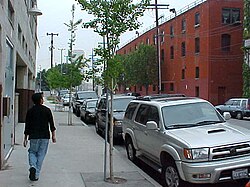Arts District, Los Angeles
| Arts District | |
|---|---|
| Neighborhood of Los Angeles | |

The Arts District
|
|
| Location within Downtown Los Angeles | |
| Coordinates: 34°02′28″N 118°13′59″W / 34.04117°N 118.23298°W | |
| Country |
|
| State |
|
| County | County of Los Angeles |
| City |
|
| Government | |
| • City Council | José Huizar |
| • U.S. House | Xavier Becerra |
| Area code(s) | 213 |
The Arts District lies on the eastern edge of Downtown Los Angeles, Los Angeles, California, United States. The gritty area has given new life to old industrial buildings whose history often dates to the early 20th century. While much of the early creative art was done behind closed doors, the street scene has slowly been activated in the early years of the 21st century as more and more factories are creatively reused with some new construction interspersed. Art galleries have opened and given recognition to the area amidst the entire downtown where Art museums and additional galleries can be found. The city community planning boundaries are Alameda Street on the west which blends into Little Tokyo, First Street on the north, the Los Angeles River to the east, and Violet Street on the south.
Vignes Street winds through the northeastern edge of the Arts District, parallel to and a couple of blocks west of the broad cement trench that memorializes the L.A. River. It is named for Jean-Louis Vignes, an aging adventurer and vintner who arrived in Los Angeles in 1831 by way of the Sandwich Islands (Hawaii) and Bordeaux. He planted grapes on 104 acres moistened by the seasonal river, ocean mists and sparse rains. The hardy Cabernet and Sauvignon Blanc vines imported from the south of France thrived there and by 1849 El Aliso, as the Vignes vineyard was called, was the largest producer of wine in California The grapes are gone, but the San Antonio Winery just north of the community is a reminder of the area’s past.
By the late 19th century, oranges and grapefruit had replaced grapes as the principal agricultural products of the area and the property west of the riverbank was thick with citrus groves. The groves provided a location for filmmaker DW Griffith who filmed parts of Hollywood’s first feature film (In Old California) there in 1909. A single grapefruit tree remains, towering over the Japanese American Plaza off San Pedro Street and Azusa.
Somewhere near Third Street and Alameda, the area’s first commercial arts enterprise opened as a print shop that employed artists from around the region who vied to create the most intriguing labels for the boxes of citrus fruit shipped across the country.
...
Wikipedia

